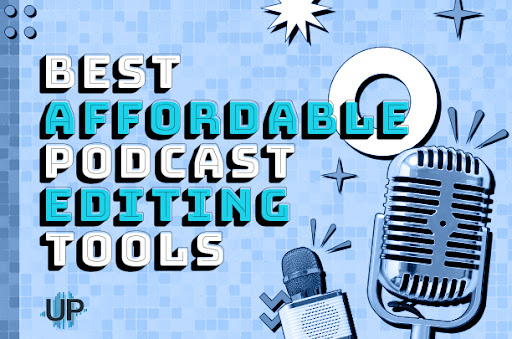
10 Podcast Editing Tools for Outstanding Shows
The raw, unedited content you record for your next podcast episode has immense potential. Whether you make the most of that potential depends on your imagination as much as on the podcast editing tool you use to produce your podcasts.
A lot is happening ‘behind the microphone’ to produce a stand-out show. Yes, I’m talking about the editing process.
Expert editing can be the difference between a ‘great’ and a ‘fantastic’ show, but it can be time-consuming. You may not feel like you have the skill set you need to do the job well.
In some cases, a podcast editing tool will also serve as a recording software. This is useful because you only need one product to handle your audio. The only exception is that you'll need a separate program to host remote talks with a co-host or guests.
There is a learning curve when it comes to podcast editing software; the more functions available, the higher the price. The good news is that there are free and low-cost options and subscription possibilities for higher-end professional versions.
Most, if not all, provide a free trial period as well. It's difficult to say which interface you might prefer unless you have experienced them all.
In what ways can a podcast editing tool help you?
Podcast editing tool doubles up as a recording software
A podcast editing tool can double up as podcast recording software. This is convenient because you only need one platform to record and edit your podcast.
The only exception is when recording remote conversations with guests or co-hosts. Most podcast editing software packages do not have a remote call recorder feature (with Alitu being the exception).
Edit (a.k.a. cutting the bad stuff out)
A podcast editing tool has two main uses. The most notable is editing the mistakes and unneeded bits. This is also where you can cut excess content from the finished episode.
Your podcast editing software can be a handy tool, but it isn't magic. It's not a substitute for proper recording methods.
If you hear a podcast with excellent audio quality, the significant elements are that the podcaster has good equipment, is utilizing it correctly, and has considered the recording setting.
Minimize background noise
Cleaning up “background noise” is another ambiguous phrase. A podcast editing tool can quickly remove constant sounds like the hiss or hum beneath the vocals created by equipment, fans, or AC units.
However, background noise, such as people shouting, door-banging, and ringing phones, are more challenging to edit.
You can certainly try with a little know-how and the correct equipment, but this audio surgery frequently leaves noticeable flaws in the audio your listeners are tuning in to.
How do you choose the right podcast editing tool for you?
Picking the right software to edit a podcast can sometimes be daunting. You will be surprised by the impact of excellent editing software on your podcast, and I'm not exaggerating.
I have listened to podcasts with great content and excellent editing skills that I would want to keep listening to.
With the wide variety of software available, it's not easy to pick software to edit your podcast. Which one you choose is influenced by how hands-on you want to be with your editing and whether you have time to learn a few new skills.
I'd be lying if I said there isn't a learning curve to podcast editing, but many free tutorials and courses are available to help you get started.
Things to consider when choosing a podcast editing tool for your show:
Cost
Price is the most important thing when looking for podcast editing software. It covers the purchase price, installation charges, maintenance fee, and other costs. The diverse service providers offer their solutions at different price points. Compare prices and choose a tool that fits within your budget.
Podcast editing tool with free trial
This tip doesn't only apply to audio software that's already free to use. You may already know how software programs work and are searching for a more comprehensive toolbox of features to suit your needs.
In this case, free trials are beneficial before purchasing any products you've never tried.
This allows you to experiment with the tool's features and gain trust in its capabilities. The good news is that if you're not satisfied, you can always go back and try different apps without spending any money.
If you purchase a subscription plan, look into the many available tiers. Most upgrades or premium plans offer many additional features for a modest price increase, delivering more value for money.
So, if you believe that upgrading to a higher membership plan will keep you inside your budget, consider doing so because the additional features could be similarly advantageous.
Ease of use
Nobody wants to use a podcast editing tool that's difficult to use. If you find free podcast editing tool but can't figure out where the audio track begins and stops, I recommend you drop it.
You should find it simple to use and straightforward to operate.
There can be a learning curve, but you should be able to adjust quickly. At the absolute least, software applications should provide online tutorials you can read or watch.
The primary goal of purchasing podcast editing tool is to help you complete projects faster, not slower. The user interface of software quickly indicates its ease of use.
Some elements can be unfamiliar to you, but generally, they should be quick to understand. Whether the task is as simple as setting a soundtrack or conducting a playback, the process should be simple.
Features
Another vital factor to consider is the features. Providers will offer a list of features. Some have numerous features, while others might seem to have only a few, even promising to have features available, only to discover that they're only available if you upgrade to their ‘pro’ subscription.
Even when software applications claim to have numerous features, this doesn't always imply that they're the better alternative.
Understanding your needs is a solid starting point for sifting through your options. Many businesses will throw any tool at you, including analytics, advanced compression, various overlays, and other features.
However, if you don't know what these are for and won't use them, why pay for something you won't use?
A good software application meets your demands. If you believe you don't want anything more than simple recording, editing, trimming, and storing, regardless of how essential the functions are, go for it.
Remember, you can always change your mind later if you find you have more advanced needs.
Setup compatibility
Compatibility reflects how well your podcast editing software works with your other tools. Your software should run effectively in your existing systems.
The key benefit of choosing the right tool is that it helps reduce your expenditures. When you buy incompatible software, you might have to modify your entire system to fit the new app.
To avoid unnecessary expenses, look for compatible software that suits your setup.
Now let’s look at podcast editing tool(s) that can fit your budget
Audacity
This tool is great to have in your tool kit if you’re just starting. It's an open-source audio recording and editing tool. DAWs are another name for such software (Digital Audio Workstations).
While it lacks several complex features, it provides all the necessary tools for a beginning podcaster to edit audio. Audacity is simple to use; drag and drop effects such as echo, phaser, reverb, and distortion, then cut and save clips.
This free podcast program includes audio restoration capabilities such as noise reduction and vocal reduction or isolation. Import, cut, copy, paste, and discard your audio files easily.
Although editing can be destructive, you have unlimited Undo and Redo. Export multiple files at once in several formats. Its easy-to-use interface is a great starter pack before you upgrade to something more complex and costly.
GarageBand
The staple Apple Music app Garage Band is most renowned for its digital instrument library and music-making capabilities. I mean, the word “band” is in the name. However, GarageBand is an underutilized podcast editing program.
The simplicity of GarageBand is straightforward: if you own a Mac, you own GarageBand. If you can make and edit music, you can do the same with your podcast episodes.
The basic level's learning curve for this has a gentle slope. GarageBand thrives where tablets and phones frequently seem cumbersome and lack editing features.
This tool provides essential noise reduction and high-quality audio, enabling the creation of rudimentary podcasts with astonishingly little effort.
If you're an iOS user, you'll be tuned to this sweet spot of convenience and functionality. This software's ease doesn't imply that it lacks advanced functionality.
GarageBand provides a very user-friendly experience that Apple consumers are used to. There are numerous effects, such as clipping tools and multitrack options.
GarageBand’s effects collection, in particular, is perfect for newer podcasters and amateurs. Paid sound effects are often prohibitive for hobbyists and smaller enterprises. This software's extensive library of free audio clips and editing material is a huge value-add.
When compared to Audacity, this freeware lacks a slew of additional capabilities. There is no separate mixing screen, MIDI editing, or other professional features.
Waveform Free
Waveform Free is the accessible version of Waveform Pro. While this has fewer features, I believe it's more suited for podcasts since the premium version mainly offers tools for mixing and manipulating music.
With third-party plug-in functionality and an unlimited track count, this podcast editing software has the potential for far more features than meets the eye.
This version is perfect for those of you who are on a budget but want to enjoy full automation and many export options. You can also modify the UI's themes, tabs, colors, and other aspects.
Waveform is more challenging to use than Audacity or AudioDirctor. I label this as one of the best podcast software for professionals on a budget since it is somewhat too complicated for beginners and far too limited for professionals.
For someone familiar with audio editing, this free podcast program has the potential to have a far more complete feature set.
Descript
It's worth mentioning Descript's evolution. Descript began as transcribing software and has evolved into a ‘no experience required' podcast editing software. The entire experience is based on text editing rather than sounds.
You can record directly into Descript or import your files. Descript will generate a transcription, which you can change by editing the text.
Don't agree with a particular sentence? You can remove it from the transcription, and the change will automatically reflect in the audio track.
There are plenty of different editing tools available to you. This unconventional editing approach may irritate more experienced producers, but it's a simple way for beginners to get started with podcasting.
Alitu
Alitu brands itself as “The Podcast Maker,” and it certainly simplifies the process of making podcast episodes. Now, is Alitu something you should consider using?
Yes, if you are a podcaster who:
- Has limited recording and editing experience
- Is not comfortable using more complicated editing applications
- Is looking for ways to save time
- Is looking for ways to make things easier and faster
Alitu is a very convenient podcast editing tool. Everything is automated, and the interface is user-friendly and straightforward.
Alitu is not suitable for experienced podcasters who use advanced audio recording and editing tools and are confident in their ability to produce high-quality audio.
Because Alitu focuses on making technical elements easier and faster using automation, you won't be able to manually make more advanced audio adjustments.
Listen to the Thoughtful Entrepreneur
More Resources from UpMyInfluence:
How to Be An Exceptional Podcast Host

